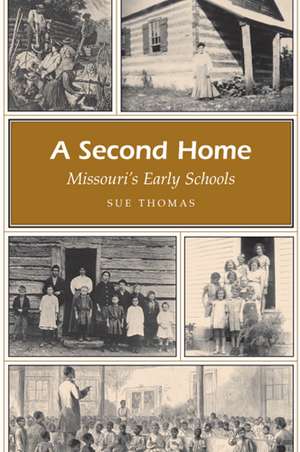A Second Home: Missouri's Early Schools: Missouri Heritage Readers
Autor Sue Thomasen Limba Engleză Paperback – aug 2006 – vârsta ani
The one-room schoolhouse may be a thing of the past, but it is the foundation on which modern education rests. Sue Thomas now traces the progress of early education in Missouri, demonstrating how important early schools were in taming the frontier.
A Second Home offers an in-depth and entertaining look at education in the days when pioneers had to postpone schooling for their children until they could provide shelter for their families and clear their fields for crops, while well-to-do families employed tutors or sent their children back east. Thomas tells of the earliest known English school at the Ramsay settlement near Cape Girardeau, then of the opening of a handful of schools around the time of the Louisiana Purchase—such as Benjamin Johnson’s school on Sandy Creek, Christopher Schewe’s school for boys when St. Louis was still a village, and the Ste. Genevieve Academy, where poor and Indian children were taught free of charge. She describes how, as communities grew, additional private schools opened—including “dame schools,” denominational schools, and subscription schools—until public education came into its own in the 1850s.
Drawing on oral histories collected throughout the state, as well as private diaries and archival research, the book is full of firsthand accounts of what education once was like—including descriptions of the furnishings, teaching methods, and school-day activities in one-room log schools. It also includes the experiences of former slaves and free blacks following the Civil War when they were newly entitled to public education, with discussions of the contributions of John Berry Meachum, James Milton Turner, and other African American leaders.
With its remembrances of simpler times, A Second Home tells of community gatherings in country schools and events such as taffy pulls and spelling bees, and offers tales of stern teachers, student pranks, and schoolyard games. Accompanying illustrations illuminate family and school life in the colonial, territorial, early statehood, and post-Civil War periods. For readers who recall older family members’ accounts or who are simply fascinated by the past, this is a book that will conjure images of a bygone time while opening a new window on Missouri history.
A Second Home offers an in-depth and entertaining look at education in the days when pioneers had to postpone schooling for their children until they could provide shelter for their families and clear their fields for crops, while well-to-do families employed tutors or sent their children back east. Thomas tells of the earliest known English school at the Ramsay settlement near Cape Girardeau, then of the opening of a handful of schools around the time of the Louisiana Purchase—such as Benjamin Johnson’s school on Sandy Creek, Christopher Schewe’s school for boys when St. Louis was still a village, and the Ste. Genevieve Academy, where poor and Indian children were taught free of charge. She describes how, as communities grew, additional private schools opened—including “dame schools,” denominational schools, and subscription schools—until public education came into its own in the 1850s.
Drawing on oral histories collected throughout the state, as well as private diaries and archival research, the book is full of firsthand accounts of what education once was like—including descriptions of the furnishings, teaching methods, and school-day activities in one-room log schools. It also includes the experiences of former slaves and free blacks following the Civil War when they were newly entitled to public education, with discussions of the contributions of John Berry Meachum, James Milton Turner, and other African American leaders.
With its remembrances of simpler times, A Second Home tells of community gatherings in country schools and events such as taffy pulls and spelling bees, and offers tales of stern teachers, student pranks, and schoolyard games. Accompanying illustrations illuminate family and school life in the colonial, territorial, early statehood, and post-Civil War periods. For readers who recall older family members’ accounts or who are simply fascinated by the past, this is a book that will conjure images of a bygone time while opening a new window on Missouri history.
Din seria Missouri Heritage Readers
-
 Preț: 84.34 lei
Preț: 84.34 lei -
 Preț: 83.30 lei
Preț: 83.30 lei - 22%
 Preț: 106.58 lei
Preț: 106.58 lei - 22%
 Preț: 106.49 lei
Preț: 106.49 lei - 26%
 Preț: 114.16 lei
Preț: 114.16 lei - 26%
 Preț: 121.41 lei
Preț: 121.41 lei - 26%
 Preț: 128.03 lei
Preț: 128.03 lei - 25%
 Preț: 148.30 lei
Preț: 148.30 lei - 29%
 Preț: 128.03 lei
Preț: 128.03 lei - 26%
 Preț: 113.72 lei
Preț: 113.72 lei - 26%
 Preț: 128.03 lei
Preț: 128.03 lei - 27%
 Preț: 113.18 lei
Preț: 113.18 lei - 26%
 Preț: 119.73 lei
Preț: 119.73 lei - 26%
 Preț: 128.03 lei
Preț: 128.03 lei - 25%
 Preț: 134.64 lei
Preț: 134.64 lei - 22%
 Preț: 127.30 lei
Preț: 127.30 lei - 26%
 Preț: 128.03 lei
Preț: 128.03 lei - 22%
 Preț: 147.61 lei
Preț: 147.61 lei - 26%
 Preț: 126.34 lei
Preț: 126.34 lei -
 Preț: 85.75 lei
Preț: 85.75 lei
Preț: 120.78 lei
Preț vechi: 163.35 lei
-26% Nou
Puncte Express: 181
Preț estimativ în valută:
23.12€ • 25.12$ • 19.43£
23.12€ • 25.12$ • 19.43£
Carte indisponibilă temporar
Doresc să fiu notificat când acest titlu va fi disponibil:
Se trimite...
Preluare comenzi: 021 569.72.76
Specificații
ISBN-13: 9780826216694
ISBN-10: 0826216692
Pagini: 160
Ilustrații: 35 illus.
Dimensiuni: 152 x 229 x 18 mm
Greutate: 0.25 kg
Ediția:First Edition
Editura: University of Missouri Press
Colecția University of Missouri
Seria Missouri Heritage Readers
ISBN-10: 0826216692
Pagini: 160
Ilustrații: 35 illus.
Dimensiuni: 152 x 229 x 18 mm
Greutate: 0.25 kg
Ediția:First Edition
Editura: University of Missouri Press
Colecția University of Missouri
Seria Missouri Heritage Readers
Notă biografică
Sue Thomas, a former elementary school teacher, is a freelance writer whose other books include The Poetry Pad, Curtain I, Curtain II, and the historical fiction novel for preteens Secesh. She lives in Kansas City.
